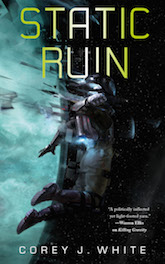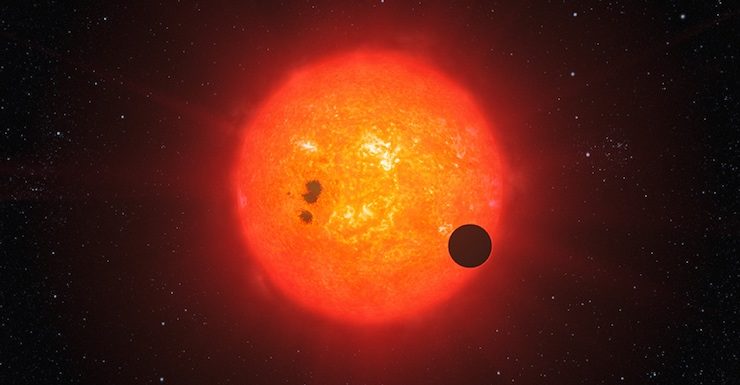Certain facts about M-class red dwarf stars are vexing for authors and readers of SF. Not to mention reviewers. I am vexed.
First fact: they’re economical. Because they are low mass, you can make a lot more of them from a given amount of matter than you can make of mid-K to mid-F class stars1). Also, they last a long long time, even by galactic standards. Someone or something must have been frugal, because the vast majority of stars are red dwarfs. This proportion will only increase once the stelliferous era draws to an end in the near future (by galactic standards).
What’s so bad about most of the galaxy being composed of long-lived stars? Well, I am happy you asked…
A lot of science fiction authors simply ignore red dwarfs, if only because simple math suggests that the odds of an Earthlike world being in the habitable zone of a red dwarf must be pretty slim. After all, the Sun is fairly bright as stars go and it only has three potentially habitable worlds in the Goldilocks zone—two of which are dead as Dillinger. A back of the envelope calculation suggests that if the Solar System is any guide, most Earthlike worlds in red dwarf systems would be too close or too far away.
But the universe does not necessarily conform to reasonable expectations. A surprising number of red dwarfs have potentially habitable worlds in their tiny Goldilocks zones (as we now know, having learned to detect extrasolar planets). Proxima Centauri, for example, has one, despite the fact that its habitable zone is roughly the width of a piece of paper. Gliese 581 has one, too. TRAPPIST-1 has three and what’s up with that? It seems any quasi-realistic setting will have not just a surfeit of red dwarfs, but a surfeit of habitable worlds orbiting them. Sorry—potentially habitable. Let me explain.
Red dwarfs are roughly as bright as a 40-watt bulb. For a world to be close enough to a red dwarf to be potentially habitable, they have to be close enough that, like our Moon with the Earth, they would be tidelocked (technically, what is called 1:1 spin-orbit resonance.). One side will perpetually face their primary and one perpetually face away2].
That’s fine for the Moon. We have an interesting view because most of the mysterious someone/something’s SF/X budget was spent on the Lunar nearside. Nothing of importance is lost because we never see the farside.
A planet, however… one side will be bathed in continual sunlight, while the other lies in Stygian darkness. In olden days, some feared this would lead all the volatiles like water and oxygen to precipitate out on the night side. Recent models suggest even a modest atmosphere would prevent that from happening. Unfortunately, proximity to the star means exposure to solar flares: goodbye atmosphere. Well, maybe.
This presents hard SF authors with the annoying possibility that the Milky Way is replete with worlds that would be habitable if only they weren’t in orbit around a red dwarf. This seems wasteful. But until our telescopes get good enough to say whether or not the potentially habitable worlds of red dwarfs are actually habitable or if they are radiation-soaked airless rocks, there are some dodges SF authors can use to handwave habitability3.
The first and easiest is to simply ignore issues like spin-orbit resonance and flares and assume habitable worlds of red dwarfs are pretty much like Earth, except that the light is a bit redder4. Example: In Rogue Queen, de Camp’s Ormazd orbits the dim star Lalande 21185, but it seems to be astonishingly Earthlike. That’s the boring solution.
The second easiest solution is to accept that there’s a vast distance between “habitable in the sense that some form of life-as-we-know it could survive there” and “habitable in the sense that humans could survive there without sophisticated technology.” Life does persist in places where humans would quickly perish, after all. So one can embrace the implications of 1:1 spin-orbit resonance and the occasional flare, and see what story ideas fall out of it. Stephen Baxter’s Proxima, for example, is set on a hypothetical planet of Proxima Centauri, one not especially friendly to humans. (To add to the misery, the world is being settled in a manner seemingly calculated to maximize human unhappiness—as one might expect from a Baxter novel.)
The third solution is to imagine a way in which tidelocking has been avoided or mitigated. Larry Niven’s Draco’s Tavern series, for example, features a race of aliens who evolved on a double planet orbiting a red dwarf; the two worlds are tide-locked to each other and not their star. The series notes that such double worlds are not exactly common, but…in a galaxy of 400 billion stars, even a small fraction is a large absolute number. The Chirps have found lots of worlds like their home. Now, given the existence of the Earth-Moon and Pluto-Charon systems, double worlds might seem like a reasonable hand-wave. On the minus side, the forces operating on such worlds may destabilize the double planets in a geologically short time. Note that no world closer to the Sun than the Earth has a natural satellite….
There are other solutions.
The Mercury Solution: spin-orbit resonance doesn’t have to be 1:1. Mercury, for example, is close enough to the Sun to be tidelocked, but for various reasons, it spins three times for every two passages around the Sun. This means it does not have a permanent day side and permanent night side. It also means that Mercury’s Solar day (the interval between noon to noon) is about twice as long as its year. Oddly, although Mercury’s 3:2 spin-orbit resonance was discovered half a century ago, I cannot think of many SF authors who were inspired to imagine worlds with 3:2 tidal locks elsewhere in the galaxy. The closest example that comes to mind is the homeworld of the alien Betans in Poul Anderson’s Avatar. Beta orbits its K3 star in about 3000 hours and is tide-locked into a 2000 hour day. Not exactly what I had in mind. If you know of a better example, please provide it in comments!
Venus offers still another solution. Venus revolves around the Sun in about 225 days. It revolves around its axis once every 243 days. It revolves backwards, because apparently Venus is the Ginger Rogers5 of the Solar System. Why there is that slight mismatch is an interesting question. The important thing is that there is one: If Venus’ spin and orbit can be slightly out of phase, so could the spin and orbit of a world orbiting Ross 128. At least until the astronomers show us otherwise. Again, Poul Anderson provides an example: in “The Three-Cornered Wheel” the planet Ivanhoe orbits a red sun, but has a day sixty hours long.
Buy the Book


Static Ruin
Note that when rotation and revolution almost but don’t quite match, solar days can be counterintuitively long. If, say, a hypothetical world orbited Proxima in 16 hours and rotated on its axis in 15 hours, 50 minutes, it would take about 1485 hours (over 60 Earth days) for Proxima to return to the same point in its world’s sky. Assuming I did not mess up the math. On the plus side, that gives inhabitants more time to get out of the ocean’s way (greater tidal forces, Bay of Fundy tides).
Again, I cannot think of a novel featuring a world with a long day, orbiting a red dwarf, but Dave Duncan’s West of January features a world, Vernier, where a near match between revolution and rotation has given it a day two Earth centuries long.
If one is a pessimist and assumes that naturally occurring habitable worlds around red dwarfs are vanishingly rare, there’s still hope. The key word there is “naturally.” What is a dead world—tidelocked to its star and scoured clean of air and water by flares—but a supreme challenge for your dedicated terraformer? Begin building shades in orbit, import the volatiles that almost certainly exist in the system6, put some hardy lifeforms to work and voila! In just ten thousand years you might have an anoxic Precambrian world!
It is a small investment of time, given that planets can be habitable for billions of years. Pity humans don’t think in those scales.
1: Wait, do I need to explain this bit? The Morgan-Keenan system rates stars from hottest to coolest thusly: O, B, A, F, G, K and M. This is easily remembered with the mnemonic obafgkm, which (as I explained to my fellow Scrabble players) is a resinous wine made from the flesh of certain cacti found in the Yukon. Or it will be, once I introduce cacti to the Yukon and convince people to start making a resinous wine from it.
I won’t get into luminosity classes except to say: if your home planet is orbiting anything that isn’t a class V main sequence star, you’re either in command of some impressive technology or very, very screwed.
2: More or less. The effects of other bodies in the system can make worlds wobble a bit, which is why pre-space-age Earth-bound observers could map more than half of the surface of the Moon.
3: One feature every habitable world will have (so obvious that authors need not mention it) is a powerful magnetic field. That should provide some protection against the charged particles in flares, although it won’t help with the x-rays.
4: Human eyes wouldn’t notice the spectrum shift, but a great many SF authors are convinced that it would be like living under a red lightbulb.
5: Ginger Rogers did everything Fred Astaire did, except backwards and in high heels.
6: It turns out water, which is made from the most common element in the universe and the third most common element in the universe, is itself pretty common, contrary to what certain television franchises would have us believe.
In the words of Wikipedia editor TexasAndroid, prolific book reviewer and perennial Darwin Award nominee James Davis Nicoll is of “questionable notability.” His work has appeared in Publishers Weekly and Romantic Times as well as on his own websites, James Nicoll Reviews and Young People Read Old SFF (where he is assisted by editor Karen Lofstrom and web person Adrienne L. Travis). He is surprisingly flammable.










